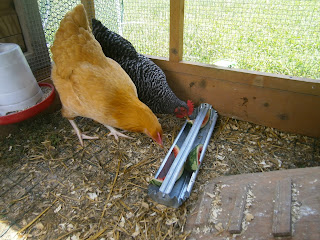How do I handle tick bites? Thankfully, I haven’t had any recent bites
but I can't seem to keep them away from my three-year-old daughter. Perhaps they are on me as well and her
pristine skin gives them away while mine just go unnoticed, but I have plucked
four ticks off her in the past two years.
However, I can’t force her to stay inside and stare out the window like
an indoor cat anxious to bust outdoors.
She needs a daily dose of nature. At first that meant she would safely watch the
trees from a Baby Bjorn and I didn’t have to worry. However, even as she began to explore on her
feet I never really thought about potentially dangerous insects, I was more
concerned she would fall in a lake or tumble off a stone wall. Basically I figured that if we steered clear
from obvious tick habitats like unkempt grasses and deep woods then we would be
relatively safe.
The latest tick finding was the one that really
threw me. She seems to have caught it simply by being outside. I never even noticed it, but thankfully my
husband spotted it attached to her neck.
Once again we sent the tick off to be evaluated; once again the little
beast was negative for Lyme and positive for Anaplasma. So while I feel
relieved that we caught it, we had to go get another supply of doxycycline and are
currently watching for strange symptoms.
I don’t mean to overreact with constant tick testing, but I
figure if I find the tick then it makes sense to be diligent. I guess I have heard too many tick horror
stories, and even if some of the lore is legend I prefer to play it safe. In the
meantime, after every tick bite I give her an immune boosting protocol which
includes echinacea, astragalus, and elderberry syrup three times a day for a
month. I also give her a bit of chopped garlic
soaked in raw honey with each substantial meal (as long as she doesn’t exhibit
stomach upset). The tick bite itself is
doused daily in an anti microbial solution of thyme, myrrh, comfrey, and
calendula until it disappears. Luckily
her tick bites have not looked angry; inflammation around the bite, even if it
isn’t in a bull’s eye pattern, can be an indicator of infection.
And of course while we are probably more aware of ticks we are not going to let them limit our outside excursions. Daily tick checks, as tedious as they are, are an imperative. In addition, light colored clothing and white socks pulled up high over her pant legs are a part of her new eccentric outdoor look. I also force a hat on her because hair tick checks always end up feeling futile. And finally a healthy application of tick repelling essential oil formula is a must have for us. We reserve the Deet for long hikes in the woods, which honestly we may avoid for awhile.
And of course while we are probably more aware of ticks we are not going to let them limit our outside excursions. Daily tick checks, as tedious as they are, are an imperative. In addition, light colored clothing and white socks pulled up high over her pant legs are a part of her new eccentric outdoor look. I also force a hat on her because hair tick checks always end up feeling futile. And finally a healthy application of tick repelling essential oil formula is a must have for us. We reserve the Deet for long hikes in the woods, which honestly we may avoid for awhile.
So I have a new healthy
attitude about ticks in Maryland. I respect them but I am not going to fear
them. After four tick bites, I hope I am
learning something.
Tick Protocol:
1) Don’t panic and carefully remove the tick with
tweezers by grasping the tick as close to the skin as possible. Do not apply anything to the bite before the
tick is removed (including alcohol). There are tick removing devices available but
the one I tried was useless for the nymph deer tick I was trying to remove, I
think it was geared toward the removal of larger ticks.
2) Disinfect the bite with alcohol and disinfect
your hands and the tweezers as well.
3) Keep
the tick! Place the tick in a plastic
baggie with a tiny bit of wet paper towel.
4) Try
to estimate how long the tick was attached and consider testing. Two labs I
have used with quick turnaround times are Clongen in Germantown, MD and UMASS
tick testing at University of Massachusetts Zoology Department.
5) Watch
the tick bite for inflammation and monitor symptoms for one month.
6) Consider
adjunct treatment with herbs to support your immune response. This could be similar
to the elderberry-astragalus-echinacea blend I give to my daughter or you could
try other herbs like andrographis, cat’s claw, or medicinal mushrooms.








